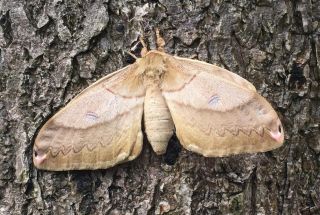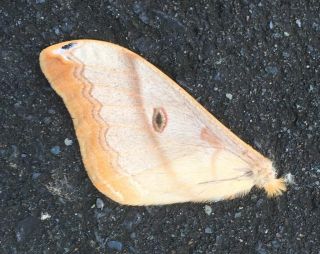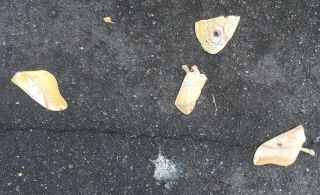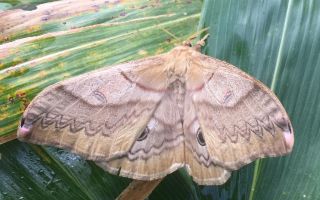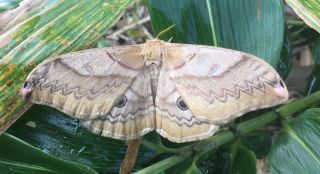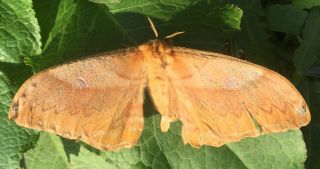Japanese Silk Worm Caligula [Saturnalia] japonica, Hokkaido © Mark Brazil
Silk-winged Emperors
By Mark Brazil | Sep 25, 2015
I watched as something fell; it was twisting, turning and descending slowly on a gentle morning breeze. It seemed at first sight to be a leaf, one that was leaving its summer home a good month earlier than one would expect. It fell lightly to the ground almost at my feet. Even before it had reached its final resting place I had perceived a clue as to its identity – and its recent fate. A Brown-eared Bulbul, like a grey-hooded and grey-cloaked thief, was fleeing the scene, disappearing into the woods with that distinctive undulating flight typical of its tribe. Did I detect a hint of guilt in its voice, in those loud “shreeping” remonstrations?
No, it wasn’t a feather falling from the bulbul. Even as the strange non-leaf, non-feather had fallen and twisted, I realized that whatever it was, it was fine, flat and roughly triangular. It was in fact a wing. A fine, flawless, but detached, wing. It, and no doubt its matching mate, had been removed in haste then instantly discarded as the bulbul devoured its prey immediately before fleeing.
A few steps further on along the path I found other pieces of this intriguing little puzzle. A sorry scattering of similar wings lay like soft tesserae on the ground, forming a mosaic-like crime scene. Seeing the first fleeing bulbul, then another following the first, and noting also a noisy Large-billed Crow in the vicinity aroused my suspicions. Had I interrupted collective foul play? It seemed that my arrival on the scene might have disturbed a meal.
A daily morning walk in Nopporo, Hokkaido, takes me along a woodland edge, but also past several streets lights in the vicinity. Atop sterile metal poles these raised lamps represent a scourge in the night for most creatures. They bring an excess of photons to what should be darkness lit only by far distant celestial bodies. Lights are like black holes for insect kind; they suck them in not via a graduated gravitational field, but by a graduated beacon of light. The lights appear faint and seemingly distant when seen from a kilometre or so away by a night flying moth or a beetle, but as one approaches, each street light becomes very rapidly brighter, like a moon fallen to Earth. To us, the lamps generate a seemingly benevolent pool of light, banishing the fear-inducing darkness of the night – realm of owls and death. Falling under the nocturnal spell of the lamps, which they perceive to be a distant light source, the night flying insects come swirling in towards them as they attempt to navigate by moonlight and starlight. They attempt to fly at a constant angle to the light, but the static lamp is deceptively close and draws them ever closer in a doom-laden spiral.
The insects flutter and flutter around the light, exhausting themselves until they either batter themselves to a senseless death on its cover, or settle close by on pole or ground unable to tear themselves away from the mesmerizing source. The new dawning day may slowly break the binding spell of the lamp, but not before they have been discovered by avian predators. Some of our smaller owls have learned that street lamps and security lights are like neon signs outside a diner that advertise food being served all night. I have watched Northern Boobook owls in Okinawa hunt in this way. Meanwhile in Hokkaido early rising bulbuls and crows are well aware of the buffet awaiting them at this man made “breakfast bar.” What I have found is the litter of their feast.
Here and there is a complete, or almost complete insect, some are, miraculously, still alive and may live for another day. The fallen wings come in gorgeously muted pastel shades. The outstretched wings curve voluptuously back from the wing rib and swoop in fine arcs along the hind wings. Patterns spread across each of the wings in curving lines, and in wavy zigs and zags. If the wing’s adornments were limited to the lined patterns it would still be a beauty, but there is more, much more. The overall colouration varies from individual to individual, some tend to more buff colours, others to warmer oranges and yet more to delicate shades of olive-green and very pale tawny-brown.
As I lift one of the survivors I notice the fine hair-like wing scales. It is as if they are sheathed in a fine fur coat. The abdomen is more heavily covered in longer fur in shades of tan and buff. Near the tips of the wings a gently curving shape resembling a letter U is black along the arms of the letter but pink in the deep well of the U and shading to a white border before the black. I notice what appear to be sleepy eyes on each of the forewings; they are rimmed with pale reddish and are slitted, as if some thing in semi slumber is peering back at me secretively from heavily lidded eyes. With the forewings spread the hind wings show a bolder version of the same eyes, but in the shape of eyes that are fully awaken and open. Rimmed above with a broad line of dark red and a finer line of white, and below with a broader band of olive and a narrower, darker line of red, this spot glistens like any shining eye. When such a moth is at rest the slitted ocelli on the folded forewings are suggestive of a creature half asleep, and the forewings cover up the hind wings. Disturb a moth like this and in a quick flash, merely by opening its forewings, its sleepy eyes instantly open revealing large, bold staring eyes.
Conventional wisdom suggests that these eyespots serve to startle prey. That is an easy assumption to make. When a nearly invisible creature suddenly reveals great eyes it is easy to imagine that an avian predator might feel that the tables were suddenly being turned. However, there may be much more to the spots than this suggests. Any bold pattern including eyespots serves to startle. They may also draw the attention of the predator to peck at them, and so avoid pecking at the more vital parts of the body. They may also serve in sexual selection, and may have many other functions we are as yet unclear about.
For several weeks now I have been finding similar scatterings of wings and occasional intact creatures on my morning walks. Early autumn (from late August to early October) it seems is the flight season for a particular moth that seems especially abundant, especially where there are oaks and walnut trees. They belong to a wonderfully named group known as Emperor Moths or Saturniidae. The species in question bears the scientific name Caligula (or Saturnia) japonica, after the nickname of Gaius Julius Caesar Augustus Germanicus, the irrational and delusional Roman emperor, while in English it is known simply as the Japanese Giant Silkworm.
Outro
Author and naturalist Dr Mark Brazil has written columns in his Wild Watch series continuously since April 1982. All Wild Watch articles dating back to 1999 are archived here for your reading pleasure. A collection of Mark’s essays The Nature of Japan has been published and is also available from www.japannatureguides.com

